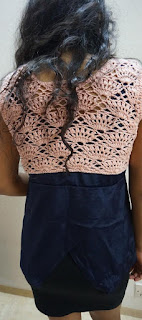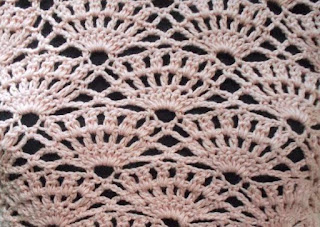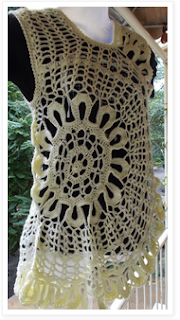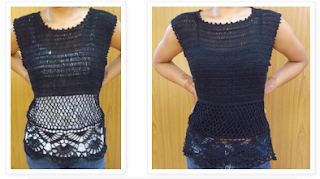SHELLED YOKE
Shells are just so .. ummm , so lovely, right ?
So using this pattern, I have made a shelled
yoke, and I plan on adding a set of sleeves and a base in fabric .. it’s a new
creation.. so come along and let’s do this together, shall we?
I was gifted this lovely , soft, unbranded
cotton yarn, but as it was only a little bit, thought this was the perfect
creation to create with it.
Thank you for joining me.
In case you have just joined me, know that you can access all of my earlier creations by checking under ‘categories’ on the right hand side of this blog under “Labels”. Then, for your convenience, follow me here or on Facebook, You Tube, Pinterest, Twitter or Instagram.
Check out all my social media handles at the bottom of this blog
Oh, and may I add that the fastest way to find any of my blogs is via Pinterest.
All my blogs can be printed. Find the printer friendly (green) link on the right side of this blog. You can also hit Control P (or Command P for Mac) on your keyboard, and the blog will go directly to the connected printer.
Remember that you only print if absolutely essential. Save paper – Save Our Earth.
Do remember to add my blog URL when you make and show off your creation.
Just copy the link on the search bar above - that's the blog URL.
Cheers. Enjoy
To purchase this or similar yarn online, click here to buy your yarns online via Amazon. While you will still pay the same, I may get paid by Amazon as well.
This is a free blog - so do pay it forward for me. Cheers.
General yarn info : This yarn is not specific for this project. Use any yarn with a suitable hook to make this to any size.
For Non-Indians : I have used a regular knitting cotton that technically uses a 2 – 2.5 mm crochet hook (recommended). I use a larger hook as I like the extra stretch it affords the end product. Among the international yarns I have used in this thickness, I’d suggest Aunt Lydia Cotton 10, Aunt Lydia Bamboo-Viscose 10, DMC Petra, Sullivans knitting cotton (Australia), Milford Soft, Hilaza Rustica Eclat , Alize cotton yarn and Alize bamboo yarn ; Lily Cream 'n Sugar ; ICE yarns ; Caron Simply Soft
Skill level :
Intermediate
Abbreviations used : (Using U.S terminology)
ch : chain ch-sp
: chain space
sp : space rep
: Repeat
fsc : Foundation single crochet
dc : Double crochet
Stitches used : (Using U.S terminology)
Instructions : (Using U.S terminology)
Please note that I start all my rows with a ch 1, turning chain for ease.
Please check the top of this blog for easy video tutorials on all stitches used in today's pattern.
Please read through all my notes before you pick up your hook, so you know just where we're heading in our pattern.
In my patterns I work with the principle of stitch count and body measurement. This means that you need to work the stitch count in pattern, till you get the measurement (length and/or width) that you need for your project.
For your convenience, I have a set of video links for regular stitches at the top of this blog, and have added some through the blog as we need them.
This is not my original pattern. I found this chart on the internet and as I work on this pattern, I’ve written down my notes that I share with you.
Quick analysis of what we’re going to do here today.
With
this stunningly simple pattern, we’re going to work our yoke for the front
first and then back, and join the two together, sides and shoulders.
So our start row needs to be half
Round Waist or half round bust (whichever is the larger measure)
Our stitch count is in in multiples of 17 + 3
Start with fsc in multiples of 17 + 3 (half round waist/ bust measure)
Half Double Crochet : Hdc : yo, insert hk into st ; yo (3 lps on hk) ;
yo, draw through all 3 lps. One hdc made.
Chainless start for Half Double Crochet : I dislike the ch-2 start, and this is what I do to start my row of hdc. Check out the video at https://youtu.be/lWXpl1KdbZ8
Single Crochet : Sc : yo, insert hk into st ; yo (2 lps on hk); yo, draw through both lps. One sc made. Check out the video at https://youtu.be/ghACqBpA-3k
Row 1 : hdc in the 1st fsc ; ch 2, sc in the next fsc ;
(ch 5, sk next 4 fsc , sc in the next
fsc ;
ch 3, sk next fsc, sc in the next fsc) ;
rep (to) till last fsc ;
ch 2, hdc in the last fsc. Turn.
Double Crochet : dc : yo, insert hk into st ; yo (3 lps on hk);
[yo, draw through 2 lps] twice. One dc made.
Chainless start for Double Crochet : I dislike the ch-2 / ch – 3 start, and this is what I do to start my row of dc.
Row 2 : dc in the 1st hdc ; 3 dc in the next ch-2 sp ;
*sc in the next ch-5 sp ;
ch 5, sc in the next ch-3 sp,
ch 5, sc in the next
ch-5 sp ; 7 dc in the next ch-3 sp* ;
rep
*to* till 2nd last ch-3 sp ;
sc in the next ch-5 sp ;
ch 5, sc in
the next ch-3 sp,
ch 5, sc in the next ch-5 sp ;
3 dc in the next ch-2 sp ; dc
in the last dc. Turn.
Row 3 : dc in the 1st dc ;
(ch 1, dc in the next dc) ;
rep (to) 2 times ;
*sc in the next ch-5 sp ; ch 5, sc in the next ch-5 sp ;
[dc
in the next dc ; rep (to) 6 times]* ;
rep *to* till last 7 dc ;
sc in the next
ch-5 sp ;
ch 5, sc in the next ch-5 sp ; dc in the next dc ;
rep (to) 3
times. Turn.
In the following row we’ll use
our dc 3-tog in the ch-1 sps.
Row 4 : dc in the 1st dc ; dc 3-tog in the next ch-1 sp
;
(ch 2, dc 3-tog in the next ch-1 sp) ;
rep (to) once ;
*ch 1, sc in the next
ch-5 sp ;
ch 1 , dc 3-tog in the next ch-1 sp ;
rep (to) 5 times* ;
rep *to*
till last ch-5 sp ;
ch 1, sc in the last ch-5 sp ;
ch 1, dc 3-tog in the next
ch-1 sp ;
rep (to) 3 times ; dc in the last dc.
Turn.
Row 5 : hdc in the 1st dc ; ch 1, sc in the next dc
3-tog ;
(ch 5, sk next dc 3-tog, sc in the next dc 3-tog) ;
*[ch 3, sk next sc,
sc in the next dc 3-tog] ;
rep (to) once ;
ch 3, sc in the next dc 3-tog ;
rep
(to) once* ;
rep *to* till last three dc 3-tog ;
rep [to] once ;
rep (to) once
;
ch 1, hdc in the last dc. Turn.
Row 6 : sc in the 1st hdc ;
ch 5, sc in the next ch-5
sp ; 7 dc in the next ch-3 sp ;
*sc in the next ch-5 sp ;
ch 5, sc in the next
ch-3 sp,
ch 5, sc in the next ch-5 sp ; 7 dc in the next ch-3 sp*
rep *to* till last ch-5 sp ;
sc in the next
ch-5 sp ;
ch 5, sc in the last hdc.
Turn.
Row 7 : dc in the 1st sc ;
ch 2, sc in the next ch-5 sp
; dc in the next dc ;
(ch 1, dc in the next dc) ;
rep
(to) 5 times ;
*sc in the next ch-5 sp ;
ch 5,
sc in the next ch-5 sp ;
[dc in the next dc ; rep (to) 6 times]* ;
rep *to*
till end ;
sc in the next ch-5 sp ;
ch 2, dc in the last sc. Turn.
In the following row we’ll use
our dc 3-tog in the ch-1 sps.
Row 8 : sc in the 1st dc ;
ch 1, dc 3-tog in the next
ch-1 sp ;
(ch 2, dc 3-tog in the next ch-1 sp) ;
rep (to) 4 times ;
*ch 1, sc
in the next ch-5 sp ; ch 1 , dc 3-tog in the next ch-1 sp ;
rep (to) 5 times* ;
rep *to* till end ;
ch 1, sc in the last dc.
Turn.
Row 9 : hdc in the 1st sc ; ch 2, sc in the next dc
3-tog ;
*(ch 5, sk next dc 3-tog, sc in the next dc 3-tog) ;
[ch 3, sk next sc,
sc in the next dc 3-tog] ;
rep (to) once ;
ch 3, sc in the next dc 3-tog* ;
rep
*to* till end ;
ch 2, hdc in the last sc.
Turn.
Rep Rows 2 – 9 till you reach
the armhole level, ending with a Row 6, where we will divide for armholes and
then neckline.
Armhole decrease row
1 :
sl-st till the 3rd dc of the 7-dc set, sc in
the next dc ;
ch 3, sk next dc, dc in the next dc ;
(ch 1, dc in the next dc) ;
*sc in the next ch-5 sp ;
ch 5,
sc in the next ch-5 sp ;
[dc in the next dc ; rep (to) 6 times]* ;
rep *to*
till last 7 dc-set ;
dc in the next dc ;
rep (to) once ;
ch 3, sk next dc, sc
in the next dc. Turn.
Armhole decrease row
2 :
sl-st in the 1st 7 ch [till the 1st
dc] ;
dc in the next dc ; dc 3-tog in the next ch-1 sp ;
*ch 1, sc in the next
ch-5 sp ;
ch 1 , dc 3-tog in the next ch-1 sp ;
(ch 1, dc in the next dc) ;
rep (to) 4 times* ;
rep *to*
till the last 2 dc ;
ch 1, sk next dc , dc 3-tog in the next ch-1 sp,
dc in the
last dc. Turn.
This completes our decrease, so
from here on till your neckline, you continue with instructions on Row 9 and
then once again repeats from Row 2 – 9.
Now for the neckline, first you
need to work out how deep you want it, and so calculate where you want to
divide for it ; and you need to mark the centre ch-2 sp on the centre shell for
that level, as that will be the centre dividing point.
Once you've reached the shoulders on one side, fasten off and weave in ends.
Re-attach the yarn and work the mirror image for the other side of the front.
Work the same instructions for the other side (i.e the back, if this is the front you've just worked). The only difference will be how deep you want the neckline.
Join the front and back shoulder. (Links given below)
Fasten off and weave in ends.
Give yourself a big pat on the
back as this one has really been a great project.
I will be attaching fabric to make the sleeves and the lower (body) part of this creation.. and decide if I want this to be a top or a dress.
And here's a closer look at the crossed cut of the fabric for the back.. let's get whacky and creative ..
So enjoy.. and let your creativity flow too.
Enjoyed this ?? I sure
did..come back right here for more freebie patterns
If you're visiting me here for the first time, and have liked the experience, do add me to your mailing list (for your convenience) , and all my future free patterns will come straight to your mail box.
I’d appreciate if you could credit my blog (and link the original pattern link) when you make your own creation. Thanks.
Have a wonderful day and see you soon. 👋🏽
I have a few tops already
made, and just
in case you want a dekho at those free patterns … here you go.
Click on the photographs and be transported to that blog page 😊
Oh, I have some yoke patterns made as well.. Enjoy
and a doll’s top..
and some bolero/jacket/vests that will look grand on a top..
I have a few girls dresses, and just in case you want a dekho at those free patterns … here you go
For cute hair embellishments and motifs check the links below.
..and some belts..
and here are a few skirt patterns that you can use your belt for..




































No comments:
Post a Comment
Thanks for taking the time to stop by. Do tell me what you think. Cheers